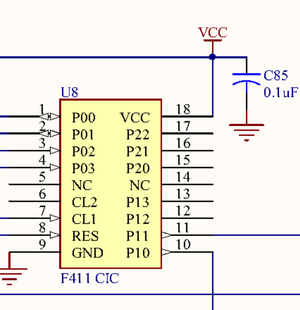We've just updated MediaWiki and its underlying software. If anything doesn't look or work quite right, please mention it to us. --RanAS
Checking Integrated Circuit: Difference between revisions
From SnesLab
(superscripted 3) |
(added SGB CIC) |
||
| Line 4: | Line 4: | ||
The CIC's program counter consists of a 3-bit bank and a 7-bit [[Polynomial Counter]]. | The CIC's program counter consists of a 3-bit bank and a 7-bit [[Polynomial Counter]]. | ||
A CIC chip exists in the [[Super Game Boy]] as well.<sup>[4]</sup> | |||
[[File:CIC schematic.png|thumb]] | [[File:CIC schematic.png|thumb]] | ||
| Line 11: | Line 13: | ||
# https://problemkaputt.de/fullsnes.htm#snescartridgeciclockoutchip | # https://problemkaputt.de/fullsnes.htm#snescartridgeciclockoutchip | ||
# [https://archive.org/details/SNESDevManual/book1/page/n98 Page 2-22-2 of Book I] of the official Super Nintendo development manual | # [https://archive.org/details/SNESDevManual/book1/page/n98 Page 2-22-2 of Book I] of the official Super Nintendo development manual | ||
# page 138 of the Game Boy Programming Manual, version 1.1 | |||
[[Category:SNES Hardware]] | [[Category:SNES Hardware]] | ||
[[Category:Integrated Circuits]] | [[Category:Integrated Circuits]] | ||
Latest revision as of 00:34, 1 August 2023
There are two CIC chips: one on the SNES Motherboard and one in the Game Pak. When the power is on, they are sending data streams to each other. If something goes wrong, the CIC in the Control Deck resets the console.
The CIC in the Control Deck has a 4.00 MHz clock, which also clocks the CIC in the Game Pak. [3]
The CIC's program counter consists of a 3-bit bank and a 7-bit Polynomial Counter.
A CIC chip exists in the Super Game Boy as well.[4]
External Links
- https://snescentral.com/chips.php?chiptype=CIC
- https://problemkaputt.de/fullsnes.htm#snescartridgeciclockoutchip
- Page 2-22-2 of Book I of the official Super Nintendo development manual
- page 138 of the Game Boy Programming Manual, version 1.1


